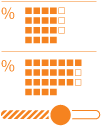- Retirement: Providing a projection of income in retirement can help savers grow confident about retirement.
- Recruitment: The unemployment rate is near multi-decade lows, creating a challenge for many employers to recruit workers.
- Retention: The cost of improving workplace plan design is much lower than the cost of replacing a key employee.
When considering the fundamentals of a retirement plan, it’s helpful to focus on the “3 Rs”: retirement, recruitment, and retention. As a plan advisor, have you adequately studied the plans you advise to understand how well they are serving both sponsor and participants along these crucial criteria?
Retirement
By definition, the reason to sponsor a retirement plan is to help participants reach their retirement goals. Some questions to consider: Is your plan on track to help people achieve a successful outcome — and how do you know that’s the case? Is it “good enough” if only a percentage of participants are saving a sufficient amount of their income?
For most people, deciding when to retire depends on knowing when they have saved enough to generate adequate retirement income. While income replacement can come from multiple sources, such as Social Security, personal savings from 401(k) or IRA accounts play a crucial role. Providing plan participants with a holistic view of the potential income their savings will generate can give them confidence to make the transition out of a company and into retirement.

Confident employees are more likely to retire at the average retirement ages of between 60 and 67. For a company, retirements create a natural rotation in the workforce. As workers retire, employees are promoted, creating new opportunities for entry-level workers. This age rotation can keep a company’s workforce younger than it would be if older workers lack confidence to retire due to insufficient plan information.
Also, age is a key determinant of benefit costs — especially health care. When the average employee age trends lower, employers may see a reduction in benefit costs.
Recruitment
The U.S. unemployment rate is at or near multi-decade lows. For nearly all industries, this presents a recruitment challenge. Industries such as trucking, manufacturing, and tech are facing tighter unemployment rates than the national average.
In this environment, every opportunity an employer has to create a more attractive offer is crucial, and knowing how your workplace plan compares with others in your industry is important. Companies that use this knowledge to their advantage can have an edge in a tight job market.
Benchmarking current plan design versus industry averages can give an employer new insights as well as data to leverage in competitive recruiting situations. By using a platform that analyzes a plan in real time and delivers a shareable “score” with job candidates, employers can demonstrate that their retirement plan is effective and attractive. This provides an advantage in competing for new employees.
Retention
Why do employees stay with a company? A fulfilling job has many dimensions, and a retirement plan is an important part of many employees’ overall compensation package. Employers recognize that competitive plan design can play a key role in helping to retain their most valuable resource: their employees.
Staffing consultant Robert Half reported that 38% of workers leave a job because of inadequate salary and benefits. Improving retirement benefits can put a company in a more competitive position. The cost of competitive plan design is much lower than the cost of replacing a key employee. The Society for Human Resource Management estimates that it costs six to nine month’s salary on average to replace a salaried employee. For example, the cost to recruit and train a worker earning $60,000 per year can be between $30,000 and $45,000.
The cost for providing a 401(k) plan is minimal compared to the cost of finding a new worker. The Bureau of Labor Statistics noted that in 2018 an employee working as a sales representative in the services industry earned an average of $71,490 per year. For the employer, the cost of that worker’s participation in a 401(k) plan was 2.0% of salary or $1,430.
Retirement, recruitment, and retention resources
For years, making retirement plans more effective for the purposes of recruitment, retaining, and retiring workers has been a great challenge for plan decision makers. Their tools for estimating the impact of changes have been limited to manual calculations on a spreadsheet, a method prone to error and insufficient for comparing multiple “what if” scenarios.
A modern tool is available. By using a state-of-the art analysis platform built to minimize the complexity of plan design inputs while maximizing the impact of the platform’s output, plan sponsors can easily evaluate their plan’s effectiveness related to retirement, recruiting, and retention.

With PlanVisualizer, advisors and sponsors can easily model multiple design scenarios while analyzing plan-level retirement readiness and estimated match expense.
Launch a demo
316715
For informational purposes only. Not an investment recommendation.
This material is provided for limited purposes. It is not intended as an offer or solicitation for the purchase or sale of any financial instrument, or any Putnam product or strategy. References to specific asset classes and financial markets are for illustrative purposes only and are not intended to be, and should not be interpreted as, recommendations or investment advice. The opinions expressed in this article represent the current, good-faith views of the author(s) at the time of publication. The views are provided for informational purposes only and are subject to change. This material does not take into account any investor’s particular investment objectives, strategies, tax status, or investment horizon. Investors should consult a financial advisor for advice suited to their individual financial needs. Putnam Investments cannot guarantee the accuracy or completeness of any statements or data contained in the article. Predictions, opinions, and other information contained in this article are subject to change. Any forward-looking statements speak only as of the date they are made, and Putnam assumes no duty to update them. Forward-looking statements are subject to numerous assumptions, risks, and uncertainties. Actual results could differ materially from those anticipated. Past performance is not a guarantee of future results. As with any investment, there is a potential for profit as well as the possibility of loss.
Diversification does not guarantee a profit or ensure against loss. It is possible to lose money in a diversified portfolio.
Consider these risks before investing: International investing involves certain risks, such as currency fluctuations, economic instability, and political developments. Investments in small and/or midsize companies increase the risk of greater price fluctuations. Bond investments are subject to interest-rate risk, which means the prices of the fund’s bond investments are likely to fall if interest rates rise. Bond investments also are subject to credit risk, which is the risk that the issuer of the bond may default on payment of interest or principal. Interest-rate risk is generally greater for longer-term bonds, and credit risk is generally greater for below-investment-grade bonds, which may be considered speculative. Unlike bonds, funds that invest in bonds have ongoing fees and expenses. Lower-rated bonds may offer higher yields in return for more risk. Funds that invest in government securities are not guaranteed. Mortgage-backed securities are subject to prepayment risk. Commodities involve the risks of changes in market, political, regulatory, and natural conditions. You can lose money by investing in a mutual fund.
Putnam Retail Management.









